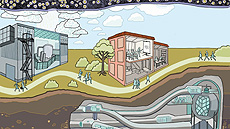When research worlds collide
 |
| Particle physicists and scientists from other disciplines are finding ways to help one another answer critical questions.
Image: Sandbox Studio with Corinne Much |
When particle physics and other fields of science meet, interesting things happen. Cosmic rays are put to use studying cloud formation. A particle detector tackles questions about aircraft engineering. Invisible particles offer clues about the interior of the Earth.
All researchers are trying to understand how the world works; they just go about it in different ways. Through interdisciplinary projects, scientists from different backgrounds can offer one another new technology, techniques and perspectives.
Researchers Jasper Kirkby of CERN, Anton Tremsin of the University of California, Berkeley, and Bill McDonough of the University of Maryland have all reached out to forge unique connections with other researchers, pursuing diverse goals with tools from particle physics.
Understanding climate with cosmic rays
Jasper Kirkby is an experimental particle physicist who's worked on several big accelerator experiments at SLAC National Accelerator Laboratory and CERN since 1972.
Nearly 20 years ago, he heard a talk about cosmic rays and cloud formation. Cloud formation is a key component of climate models because clouds scatter sunlight, providing a cooling effect in the atmosphere. As Kirkby learned at the talk, cloud formation seemed to correlate with the appearance of cosmic rays, high-energy particles — mostly protons — that rain on the Earth from space.
Clouds form when water condenses around aerosol particles, tiny liquid or solid particles suspended in the air. It was speculated that cosmic rays ionizing atmospheric vapors could help these cloud seeds to form. However, both aerosol particle formation and atmospheric vapors are poorly understood.
After the talk, Kirkby wrote a paper about how this process could be investigated under controlled conditions in the laboratory using an ultra-clean atmospheric chamber and a proton beam to simulate the cosmic rays. He called the proposed chamber CLOUD, for Cosmics Leaving Outdoor Droplets. Kirkby then went on a roadshow around Europe to discuss his ideas with the atmospheric community, starting at University of Berne in May 1998.
Read more
—Amanda Solliday
|